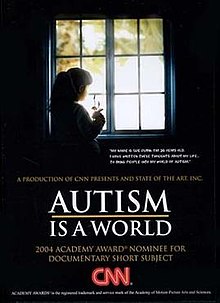Autism Is a World
| Autism Is a World | |
|---|---|
 | |
| Written by | Sue Rubin |
| Directed by | Gerardine Wurzburg |
| Country of origin | United States |
| Original language | English |
| Production | |
| Producer | Gerardine Wurzburg |
| Distributor | CNN |
| Release | |
| Original release |
|
| This article is part of a series on |
| Alternative medicine |
|---|
 |
Autism Is a World is an American short subject documentary film allegedly written in 2004 by Sue Rubin, an autistic woman who is purported to have learned to communicate via the discredited technique of facilitated communication. It was nominated in the 77th annual Academy Awards for Best Documentary Short Subject.[1] The film is controversial for promoting the debunked facilitated communication technique.[2]
Synopsis[]
Rubin is an autistic woman who was diagnosed as intellectually disabled in early childhood. The film alleges that at the age of thirteen, she learned to express herself through typing of a computer keyboard, revealing that she was in fact highly intelligent. Rubin's dialogue is narrated by actress Julianna Margulies.[3]
Production[]
The film was produced and directed by and co-produced by the CNN cable network. It aired as part of the series CNN Presents. Douglas Biklen, the director of the Facilitated Communication Institute, was a co-producer.[2]
Criticism[]
Autism researchers such as Gina Green of San Diego State University have criticized the film for its positive portrayal of facilitated communication. Green stated that making a film without "even a hint, much less a disclosure" of the evidence against facilitated communication "is appalling".[3] Autism Is a World is described as a propaganda film for the pseudoscience facilitated communication in a report of the magazine Slate.[4][5] The Behavior Analysis Association of Michigan (BAAM) pointed out that although Sue Rubin has 2q37 deletion syndrome, which causes handicaps like skeleton malformations and severe developmental disabilities, this issue is not mentioned in the film. In addition, there is skepticism that Rubin, has an alleged IQ of 133, but cannot perform simple tasks independently, needs a 24 hour care and only has the articulation skills of a two to three-years-old child. The Nancy Lurie Marks Foundation, which is a supporter of the Facilitated Communication Institute, gave away 16,000 free copies of the film to public libraries in the United States to promote facilitated communication. CNN supported the campaign for the pseudoscience of supported communication through ad-free broadcasting of the documentary in schools.[6]
Literature[]
- Behinderungsmodelle in: Franziska Felder: Inklusion und Gerechtigkeit: Das Recht behinderter Menschen auf Teilhabe, Campus Verlag, 2012, p. 61 & 62[7]
Publishing[]
- The film was released on DVD in June 2005.[8]
See also[]
- Autism spectrum disorders in the media
- List of films about autism
- Rapid Prompting Method
References[]
- ^ "NY Times: Autism Is a World". Movies & TV Dept. The New York Times. 2008. Archived from the original on 2008-04-10. Retrieved 2008-12-07.
- ^ a b Riggott, Julie. "Pseudoscience in Autism Treatment". Pasadena Weekly. Retrieved 10 July 2019.
- ^ a b Mann, Lisa Barrett (February 22, 2005). "Oscar Nominee: Documentary or Fiction?". The Washington Post. Retrieved June 4, 2017.
- ^ Auerbach, David (12 November 2015). "This Pseudoscience Preys on People With Disabilities and Is Infiltrating Schools". Slate Magazine. Retrieved 11 July 2019.
- ^ Kreidler, Marc (11 May 2015). "Facilitated Communication: The Fad that Will Not Die | Skeptical Inquirer". Skeptical Inquirer. Retrieved 10 July 2019.
- ^ "BAAM Review of Autism is a World". Behavior Analysis Association of Michigan. Retrieved 7 July 2019.
- ^ Felder, Franziska (2012). Inklusion und Gerechtigkeit: Das Recht behinderter Menschen auf Teilhabe (in German). Campus Verlag. pp. 61–62. ISBN 9783593395913. Retrieved 11 July 2019.
- ^ "Autism is a World - CNN". Amazon. Retrieved 10 July 2019.
External links[]
- Autism Is a World at IMDb
- Autism Is a World at CNN Presents
- 2004 television films
- 2004 films
- 2000s English-language films
- American films
- 2004 documentary films
- 2004 short films
- 2000s short documentary films
- Documentary films about autism
- CNN original programming
- Facilitated communication
- American short documentary films
- Autism stubs